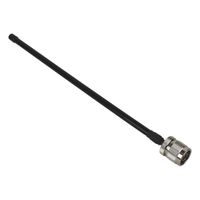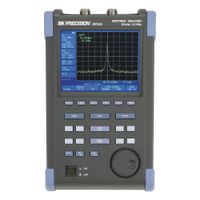Call +(254) 703 030 000 / 751 483 999 / 721 704 777
- Home
- Test Instruments
- Electronic Bench Testing
- Spectrum Analyzers Accessories
.....Read More
Frequently Asked Questions
What is a spectrum analyzer and how does it work?
A spectrum analyzer is an electronic device used to measure and display the frequency spectrum of an input signal. It provides a visual representation of signal amplitude (usually in decibels) versus frequency, allowing users to analyze the frequency components within a signal. Spectrum analyzers are essential tools in various fields, including telecommunications, audio engineering, and electronics testing.
The operation of a spectrum analyzer involves several key steps:
1. **Input Signal Reception**: The device receives the input signal, which can be in the form of electrical signals from antennas, cables, or other sources.
2. **Frequency Conversion**: The input signal is typically converted to an intermediate frequency (IF) using a process called heterodyning. This involves mixing the input signal with a local oscillator signal to shift the frequency range to a more manageable level for analysis.
3. **Filtering**: The IF signal is passed through a series of filters to isolate specific frequency components. These filters can be adjusted to focus on particular frequency bands of interest.
4. **Detection**: The filtered signal is then detected to convert it into a form suitable for display. This often involves rectifying the signal and applying a logarithmic scale to represent amplitude in decibels.
5. **Display**: The processed signal is displayed on a screen, typically as a graph with frequency on the horizontal axis and amplitude on the vertical axis. This visual representation allows users to identify and analyze different frequency components, such as harmonics, noise, and spurious signals.
Spectrum analyzers can be analog or digital, with digital models offering advanced features like real-time analysis, higher accuracy, and the ability to store and process data. They are crucial for tasks such as identifying signal interference, measuring bandwidth, and ensuring compliance with regulatory standards.
How do I choose the right spectrum analyzer for my needs?
1. **Frequency Range**: Determine the frequency range you need to analyze. Ensure the spectrum analyzer covers the necessary range for your applications.
2. **Resolution Bandwidth (RBW)**: Choose an analyzer with appropriate RBW settings to distinguish between closely spaced signals.
3. **Dynamic Range**: Consider the dynamic range to accurately measure both weak and strong signals without distortion.
4. **Phase Noise**: Select an analyzer with low phase noise for precise measurements, especially important in communication systems.
5. **Amplitude Accuracy**: Ensure the analyzer provides high amplitude accuracy for reliable signal strength measurements.
6. **Sweep Speed**: Faster sweep speeds are beneficial for capturing transient signals and reducing measurement time.
7. **Display and Interface**: Look for a user-friendly interface and a clear display for easy operation and data interpretation.
8. **Connectivity and Data Export**: Check for connectivity options like USB, LAN, or GPIB for data export and remote control.
9. **Portability**: If field measurements are required, consider a portable or handheld spectrum analyzer.
10. **Budget**: Balance your needs with your budget, considering both initial costs and potential future upgrades.
11. **Software and Features**: Evaluate the software capabilities and additional features like signal analysis, demodulation, or tracking generators.
12. **Brand and Support**: Choose a reputable brand with good customer support and service options.
13. **Future-Proofing**: Consider potential future needs and ensure the analyzer can accommodate them, either through upgrades or modular options.
14. **Application-Specific Requirements**: Tailor your choice based on specific applications, such as RF design, EMC testing, or audio analysis.
What are the key features to look for in a spectrum analyzer?
1. **Frequency Range**: Ensure the spectrum analyzer covers the frequency range required for your application, from low frequencies to potentially several GHz.
2. **Resolution Bandwidth (RBW)**: Look for adjustable RBW settings to distinguish between closely spaced signals and improve measurement accuracy.
3. **Dynamic Range**: A wide dynamic range is crucial for detecting weak signals in the presence of strong ones without distortion.
4. **Phase Noise**: Low phase noise is important for accurate signal analysis, especially in applications like communication systems.
5. **Amplitude Accuracy**: High amplitude accuracy ensures precise measurement of signal power levels.
6. **Sweep Speed**: Fast sweep speeds allow for quicker analysis and are beneficial in dynamic environments.
7. **Display and Interface**: A clear, high-resolution display and user-friendly interface enhance usability and data interpretation.
8. **Connectivity Options**: USB, LAN, and GPIB connectivity facilitate data transfer and remote operation.
9. **Tracking Generator**: Useful for network analysis, allowing the spectrum analyzer to function as a scalar network analyzer.
10. **Pre-amplifier**: Built-in pre-amplifiers improve sensitivity for detecting low-level signals.
11. **Signal Demodulation**: Capability to demodulate various signal types (AM, FM, digital) for comprehensive analysis.
12. **Portability**: Consider size and weight if field measurements are required.
13. **Software and Firmware**: Ensure compatibility with analysis software and regular firmware updates for enhanced functionality.
14. **Memory and Storage**: Adequate memory for storing measurement data and settings.
15. **Calibration and Accuracy**: Regular calibration options and high accuracy are essential for reliable measurements.
16. **Cost and Support**: Balance features with budget constraints and ensure good manufacturer support and warranty.
How can spectrum analyzers identify transient or short-lived issues?
Spectrum analyzers identify transient or short-lived issues by capturing and analyzing the frequency domain of signals over time. They use several techniques to achieve this:
1. **Real-Time Analysis**: Modern spectrum analyzers can perform real-time analysis, capturing and processing data continuously without gaps. This allows them to detect transient events that occur for very short durations.
2. **Fast Fourier Transform (FFT)**: By using FFT, spectrum analyzers convert time-domain signals into frequency-domain data quickly. This rapid processing helps in identifying transient signals that might be missed with slower methods.
3. **Triggering Mechanisms**: Spectrum analyzers are equipped with advanced triggering options that can be set to capture specific events. For instance, they can be configured to trigger on a particular frequency, amplitude, or pattern, ensuring that transient events are captured when they occur.
4. **Persistence Mode**: This feature allows the spectrum analyzer to display signals over time, showing how often certain frequencies appear. It helps in visualizing transient events by displaying them as changes in the persistence display.
5. **Spectrograms**: By using spectrograms, spectrum analyzers provide a time-varying spectral representation, allowing users to see how the frequency content of a signal changes over time. This is particularly useful for identifying short-lived events.
6. **High Sampling Rates**: High sampling rates enable the capture of fast-changing signals, ensuring that transient events are not missed.
7. **Data Recording and Playback**: Some spectrum analyzers can record data for later analysis, allowing users to review and identify transient events that occurred during the recording period.
By combining these features, spectrum analyzers effectively identify and analyze transient or short-lived issues in various applications, from telecommunications to electronic testing.
What accessories are essential for enhancing spectrum analyzer capabilities?
To enhance the capabilities of a spectrum analyzer, several essential accessories can be utilized:
1. **Pre-amplifiers**: These are used to boost weak signals before they enter the spectrum analyzer, improving sensitivity and allowing for the detection of low-level signals.
2. **Attenuators**: These devices reduce the power of a signal without distorting its waveform, protecting the spectrum analyzer from high-power signals that could cause damage or distortion.
3. **Mixers**: Mixers extend the frequency range of a spectrum analyzer by converting higher frequency signals to a lower frequency range that the analyzer can process.
4. **Filters**: Bandpass, low-pass, high-pass, and notch filters can be used to eliminate unwanted frequencies, reducing noise and improving measurement accuracy.
5. **Directional Couplers**: These are used to sample a signal from a transmission line without interrupting the main signal flow, allowing for non-intrusive measurements.
6. **Probes**: Various types of probes, such as near-field, active, and passive probes, are used to connect the spectrum analyzer to the device under test, ensuring accurate signal capture.
7. **Cables and Connectors**: High-quality RF cables and connectors are essential for maintaining signal integrity and minimizing losses between the device under test and the spectrum analyzer.
8. **Tracking Generators**: When paired with a spectrum analyzer, tracking generators enable scalar network analysis, allowing for the measurement of frequency response, insertion loss, and return loss.
9. **Software**: Advanced software packages can enhance data analysis, visualization, and reporting capabilities, providing deeper insights into the measured signals.
10. **Calibration Kits**: These kits ensure that the spectrum analyzer and its accessories are accurately calibrated, maintaining measurement precision and reliability.
These accessories collectively enhance the functionality, accuracy, and versatility of spectrum analyzers, making them more effective for a wide range of applications.
How do I maintain and calibrate a spectrum analyzer?
To maintain and calibrate a spectrum analyzer, follow these steps:
1. **Regular Cleaning**: Keep the spectrum analyzer clean by wiping it with a soft, lint-free cloth. Avoid using harsh chemicals. Ensure the ventilation ports are free from dust to prevent overheating.
2. **Visual Inspection**: Regularly inspect the device for any physical damage, loose connections, or worn-out cables. Check connectors for wear and replace if necessary.
3. **Firmware Updates**: Keep the spectrum analyzer's firmware up to date. Manufacturers often release updates to improve performance and fix bugs.
4. **Self-Calibration**: Many modern spectrum analyzers have built-in self-calibration features. Run these routines periodically as recommended by the manufacturer to ensure accuracy.
5. **External Calibration**: Schedule regular external calibration with a certified calibration lab. This should be done annually or as specified by the manufacturer. External calibration involves comparing the analyzer's measurements against a known standard to ensure accuracy.
6. **Warm-Up Time**: Allow the spectrum analyzer to warm up for the recommended time before use. This ensures stable and accurate measurements.
7. **Environmental Conditions**: Operate the spectrum analyzer within the specified environmental conditions, such as temperature and humidity, to maintain accuracy.
8. **Proper Handling**: Handle the spectrum analyzer carefully to avoid mechanical shocks. Use appropriate cases or covers when transporting the device.
9. **Documentation**: Keep detailed records of all maintenance and calibration activities. This includes dates, results, and any adjustments made.
10. **Training**: Ensure that all users are properly trained in the operation and maintenance of the spectrum analyzer to prevent misuse and damage.
By following these steps, you can maintain the accuracy and longevity of your spectrum analyzer.
What are common troubleshooting steps for spectrum analyzer issues?
1. **Check Power Supply**: Ensure the spectrum analyzer is properly connected to a power source and the power switch is on. Verify that the power cable and connections are secure.
2. **Inspect Connections**: Examine all cables and connectors for damage or loose connections. Ensure that the input signal is properly connected to the correct input port.
3. **Verify Settings**: Confirm that the spectrum analyzer settings are correctly configured for the measurement. Check frequency range, resolution bandwidth, and amplitude settings.
4. **Calibrate the Device**: Perform a self-calibration or use an external calibration source to ensure the spectrum analyzer is operating accurately.
5. **Check Input Signal**: Ensure the input signal is within the frequency and amplitude range of the spectrum analyzer. Use an oscilloscope to verify the signal if necessary.
6. **Review Software/Firmware**: Ensure the spectrum analyzer’s software or firmware is up to date. Check for any available updates from the manufacturer.
7. **Perform a Factory Reset**: If settings are misconfigured, perform a factory reset to restore default settings. Be aware this will erase custom settings.
8. **Test with Known Good Equipment**: Use a known good signal source and cables to determine if the issue is with the spectrum analyzer or the input signal.
9. **Check for Overload**: Ensure the input signal is not overloading the spectrum analyzer. Use attenuation if necessary to reduce signal amplitude.
10. **Consult the Manual**: Refer to the user manual for specific troubleshooting steps and error codes related to your model.
11. **Contact Support**: If issues persist, contact the manufacturer’s technical support for assistance or consider professional servicing.

